Buying a new fertiliser spreader isn’t always financially viable or even necessary. The used market can offer value for money with well-minded machines which still have years of use left in them often popping up. With the recent news that GPS fertiliser spreaders are now available for all farmers under Tranche 21 of the TAMS II scheme, it will mean even more tidy used spreaders should become available.
When in the market for a used fertiliser spreader, it is no different to buying any used machine. A first glance will tell a lot about how well the spreader was previously maintained.
General condition
The general condition of a fertiliser spreader is very important. Artificial fertiliser is a corrosive product. The nature of the material means that rust will always be a challenge – it never sleeps.
If a spreader is not washed down and oiled properly after each use before it is parked up, it will begin to rust and corrode, regardless of age.
Rust, faded paintwork and weathered or dull-looking plastic components generally indicate that the spreader has spent time stored outdoors, exposed to the elements. Small spots or streaks on sharp edges is nothing to worry unduly about, but should be taken into account when agreeing a price.
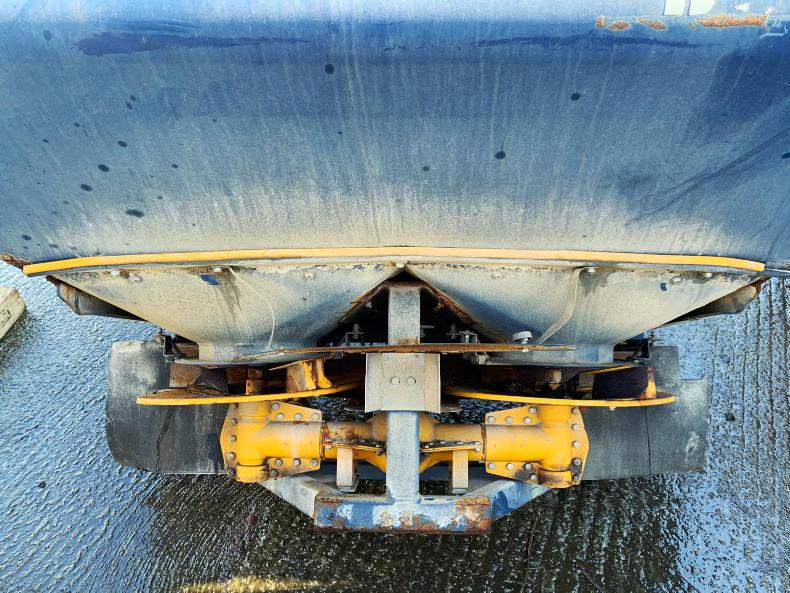
Steer clear from a machine that has been structurally impacted by rust unless its price reflects this and you are prepared to have it refurbished.
Dry storage isn’t always possible but is crucial to the proper maintenance and long working life of any machine.
Chassis and hopper
Closely examine the hopper for damage, cracks or strain, common results of overloading. If the previous owner constantly lowered the spreader down on the ground too quickly while loaded, it may have caused damage to the joints between the hopper and the frame.
Obviously, the chassis and hopper should show little signs of rusting. Check the smaller nooks and crannies where fertiliser build-up may have occurred. All nuts and bolts should be present and tight. Loose bolts will allow movement to occur and damage the machine’s paintwork, leaving it vulnerable to rust.
Steer clear of a machine that has been structurally impacted by rust unless its price reflects this and you are prepared to have it refurbished. Rust can be common on the frame underneath discs where fine dust sits and may have worked its way into the frame. This is very common on machines that have been poorly washed down.
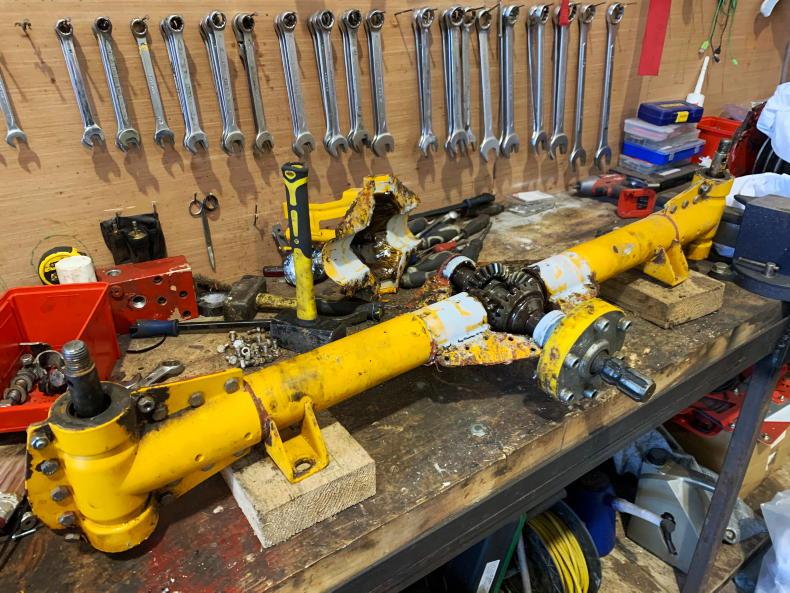
Check for play in gearbox shafts if possible, which if present will indicate that a bearing may be failing.
Gearbox and slip clutch
It is advised to see the spreader working or ensure it comes with a guarantee that its gearboxes and slip clutch are in good order. Ideally you want a machine with a dry gearbox (exterior). Otherwise the gearbox may be leaking oil. Look for signs that gearboxes may have been opened (paint removed off bolt heads, etc). If this is the case it is likely that bearings or oil seals have been replaced at some point. Check for play in gearbox shafts if possible, which will indicate that a bearing may be failing.
It is worth examining gearbox oil level and quality. Check for metal filings, which would indicate cog wear, or milky-looking oil, indicating seal failure. A gearbox in need of major repair may be cheaper to replace than refurbish, so account for this in the buying price.
Slip clutches should be functioning. Engaging the PTO on a loaded machine with a seized or non-operational slip clutch will lead to gearbox damage. On some machines evidence of this will be first seen when the gearbox begins sticking in either headland or non-headland mode. So, check that headland mode is engaging and disengaging correctly. If the spreader is fitted with a fold-down headland kit, ensure it is fully functional.
Vanes and discs
The discs and accompanying vanes work hand in hand, taking much of the wear in a spreader. Their condition is very important for consistent and accurate spreading.
The vanes should be tightly secured in the correct position. The leading edge should be straight and its face which comes into contact with fertiliser should be smooth. Vanes with a wrinkled effect are worn. Vanes with a track worn against the top lip will also need replacing. This track will cause a deviation in the spread pattern, meaning the fertiliser won’t be able to flow off the vane evenly.
Depending on the make and model, a new set of genuine vanes to fit a typical farmer-specification machine will cost in the region of €350 to €400 plus VAT.
In terms of the discs, they won’t wear. However, it is important to assess their condition, and ensure that they are damage-free. Potential buyers should check the disc for vertical play or rocking. It may indicate that the gearbox bearings need to be replaced. Most manufacturers say that minor play (1mm) is okay but anything more will need attention. These bearings are often maintenance-free or sealed as part of the gearbox. If replacing one bearing, then replace the other for peace of mind.
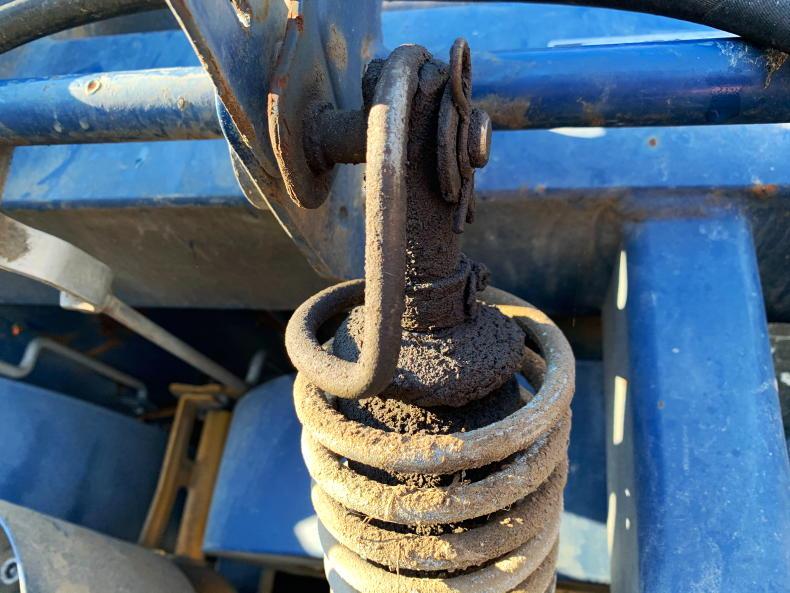
If the shutters are opened hydraulically, the ram and spring setup should be checked over.
Hopper shutters/agitator
Depending on the manufacturer, some will use single shutter or twin shutter designs. Regardless of the design, the shutters should open and close to an equal width. If not, they can be adjusted on all machines so ensure they are operating properly before buying.
If the shutters are opened hydraulically, the ram and spring setup should be checked ensuring the seal is not leaking oil. When checking this, check the condition of the hydraulic hose and coupling. The springs should also be checked for stretching.
If they are electrically opened and closed, check the electric actuators for wear and listen for grinding sounds from the motors. In all cases, shutters should move freely even if they are manually adjusted. Check the linkage bars that close them as a bent bar means a stiff or almost seized shutter.
The agitators are important for a consistent, even flow of fertiliser. Different manufacturers use different systems such as a finger agitator or a spiral agitator. All agitators, horizontal or vertical, will need to be checked for bearing play. If the finger/spiral agitator is being held in using an R-clip, then the same restraint should be used on both sides.
Hopper grills, cover and safety
The majority of twin-disc machines are fitted with grills which serve a number of purposes. They prevent foreign objects or lumps of fertiliser making contact with the agitators as well as preventing the operator making contact with the shutters or agitators. Ensure these grills are present and secure in position.
A hopper cover is not essential but a nice feature if fitted. A good cover will keep dirt and water out. Check its hinges and that the canvas has no major rips or tears. Have small cuts repaired to prevent them getting any worse. A new canvas may prove costly.
It is essential that the PTO cover is present and not damaged. Check for wear on both universal joints, in particular the joint on the machine side as this is the one often to receive least grease given its tricky location. Larger spreaders fitted with tail lights should have their functionality checked as the spreader hopper may block the tractor’s tail lights.
It’s very important that used machines are purchased with a calibration kit. It is vital the vanes are correctly calibrated in order to broadcast various blends and mixes of fertiliser accurately. Calibration kits can be purchased, but at an added cost. Most manufacturers use an app to determine machine settings, however, the calibration hardware is still required and recommended.
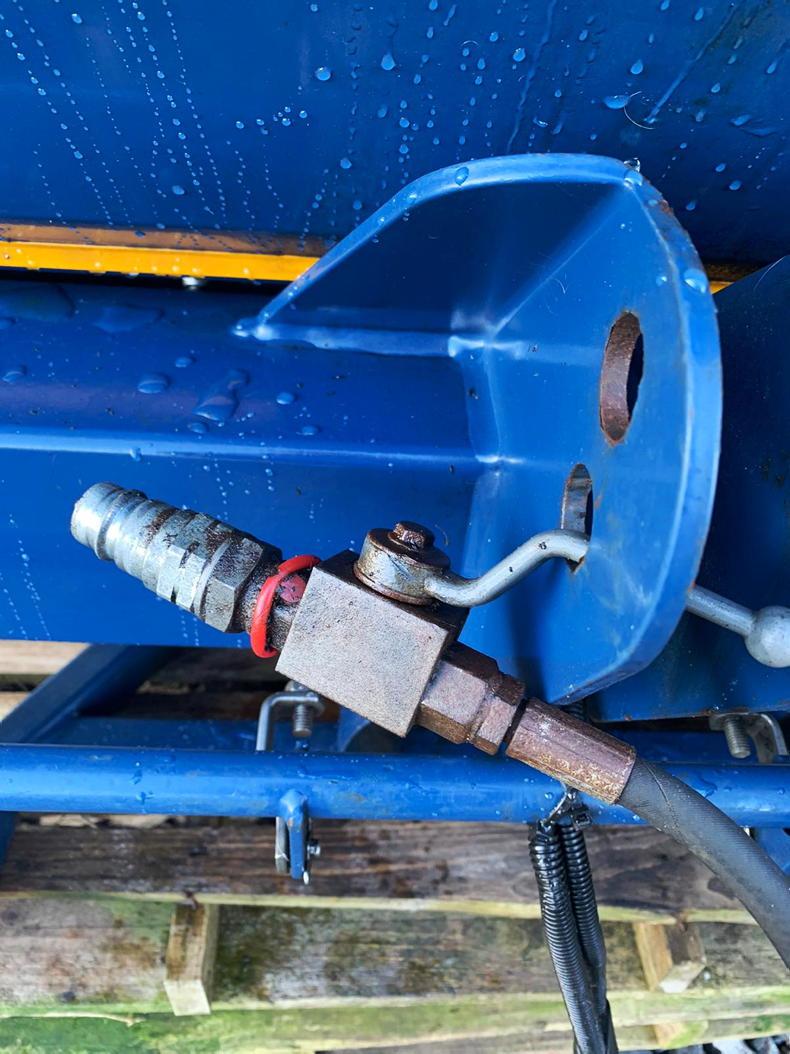
The condition of hydraulic hoses should be checked over.
Buying a new fertiliser spreader isn’t always financially viable or even necessary. The used market can offer value for money with well-minded machines which still have years of use left in them often popping up. With the recent news that GPS fertiliser spreaders are now available for all farmers under Tranche 21 of the TAMS II scheme, it will mean even more tidy used spreaders should become available.
When in the market for a used fertiliser spreader, it is no different to buying any used machine. A first glance will tell a lot about how well the spreader was previously maintained.
General condition
The general condition of a fertiliser spreader is very important. Artificial fertiliser is a corrosive product. The nature of the material means that rust will always be a challenge – it never sleeps.
If a spreader is not washed down and oiled properly after each use before it is parked up, it will begin to rust and corrode, regardless of age.
Rust, faded paintwork and weathered or dull-looking plastic components generally indicate that the spreader has spent time stored outdoors, exposed to the elements. Small spots or streaks on sharp edges is nothing to worry unduly about, but should be taken into account when agreeing a price.

Steer clear from a machine that has been structurally impacted by rust unless its price reflects this and you are prepared to have it refurbished.
Dry storage isn’t always possible but is crucial to the proper maintenance and long working life of any machine.
Chassis and hopper
Closely examine the hopper for damage, cracks or strain, common results of overloading. If the previous owner constantly lowered the spreader down on the ground too quickly while loaded, it may have caused damage to the joints between the hopper and the frame.
Obviously, the chassis and hopper should show little signs of rusting. Check the smaller nooks and crannies where fertiliser build-up may have occurred. All nuts and bolts should be present and tight. Loose bolts will allow movement to occur and damage the machine’s paintwork, leaving it vulnerable to rust.
Steer clear of a machine that has been structurally impacted by rust unless its price reflects this and you are prepared to have it refurbished. Rust can be common on the frame underneath discs where fine dust sits and may have worked its way into the frame. This is very common on machines that have been poorly washed down.

Check for play in gearbox shafts if possible, which if present will indicate that a bearing may be failing.
Gearbox and slip clutch
It is advised to see the spreader working or ensure it comes with a guarantee that its gearboxes and slip clutch are in good order. Ideally you want a machine with a dry gearbox (exterior). Otherwise the gearbox may be leaking oil. Look for signs that gearboxes may have been opened (paint removed off bolt heads, etc). If this is the case it is likely that bearings or oil seals have been replaced at some point. Check for play in gearbox shafts if possible, which will indicate that a bearing may be failing.
It is worth examining gearbox oil level and quality. Check for metal filings, which would indicate cog wear, or milky-looking oil, indicating seal failure. A gearbox in need of major repair may be cheaper to replace than refurbish, so account for this in the buying price.
Slip clutches should be functioning. Engaging the PTO on a loaded machine with a seized or non-operational slip clutch will lead to gearbox damage. On some machines evidence of this will be first seen when the gearbox begins sticking in either headland or non-headland mode. So, check that headland mode is engaging and disengaging correctly. If the spreader is fitted with a fold-down headland kit, ensure it is fully functional.
Vanes and discs
The discs and accompanying vanes work hand in hand, taking much of the wear in a spreader. Their condition is very important for consistent and accurate spreading.
The vanes should be tightly secured in the correct position. The leading edge should be straight and its face which comes into contact with fertiliser should be smooth. Vanes with a wrinkled effect are worn. Vanes with a track worn against the top lip will also need replacing. This track will cause a deviation in the spread pattern, meaning the fertiliser won’t be able to flow off the vane evenly.
Depending on the make and model, a new set of genuine vanes to fit a typical farmer-specification machine will cost in the region of €350 to €400 plus VAT.
In terms of the discs, they won’t wear. However, it is important to assess their condition, and ensure that they are damage-free. Potential buyers should check the disc for vertical play or rocking. It may indicate that the gearbox bearings need to be replaced. Most manufacturers say that minor play (1mm) is okay but anything more will need attention. These bearings are often maintenance-free or sealed as part of the gearbox. If replacing one bearing, then replace the other for peace of mind.

If the shutters are opened hydraulically, the ram and spring setup should be checked over.
Hopper shutters/agitator
Depending on the manufacturer, some will use single shutter or twin shutter designs. Regardless of the design, the shutters should open and close to an equal width. If not, they can be adjusted on all machines so ensure they are operating properly before buying.
If the shutters are opened hydraulically, the ram and spring setup should be checked ensuring the seal is not leaking oil. When checking this, check the condition of the hydraulic hose and coupling. The springs should also be checked for stretching.
If they are electrically opened and closed, check the electric actuators for wear and listen for grinding sounds from the motors. In all cases, shutters should move freely even if they are manually adjusted. Check the linkage bars that close them as a bent bar means a stiff or almost seized shutter.
The agitators are important for a consistent, even flow of fertiliser. Different manufacturers use different systems such as a finger agitator or a spiral agitator. All agitators, horizontal or vertical, will need to be checked for bearing play. If the finger/spiral agitator is being held in using an R-clip, then the same restraint should be used on both sides.
Hopper grills, cover and safety
The majority of twin-disc machines are fitted with grills which serve a number of purposes. They prevent foreign objects or lumps of fertiliser making contact with the agitators as well as preventing the operator making contact with the shutters or agitators. Ensure these grills are present and secure in position.
A hopper cover is not essential but a nice feature if fitted. A good cover will keep dirt and water out. Check its hinges and that the canvas has no major rips or tears. Have small cuts repaired to prevent them getting any worse. A new canvas may prove costly.
It is essential that the PTO cover is present and not damaged. Check for wear on both universal joints, in particular the joint on the machine side as this is the one often to receive least grease given its tricky location. Larger spreaders fitted with tail lights should have their functionality checked as the spreader hopper may block the tractor’s tail lights.
It’s very important that used machines are purchased with a calibration kit. It is vital the vanes are correctly calibrated in order to broadcast various blends and mixes of fertiliser accurately. Calibration kits can be purchased, but at an added cost. Most manufacturers use an app to determine machine settings, however, the calibration hardware is still required and recommended.

The condition of hydraulic hoses should be checked over.








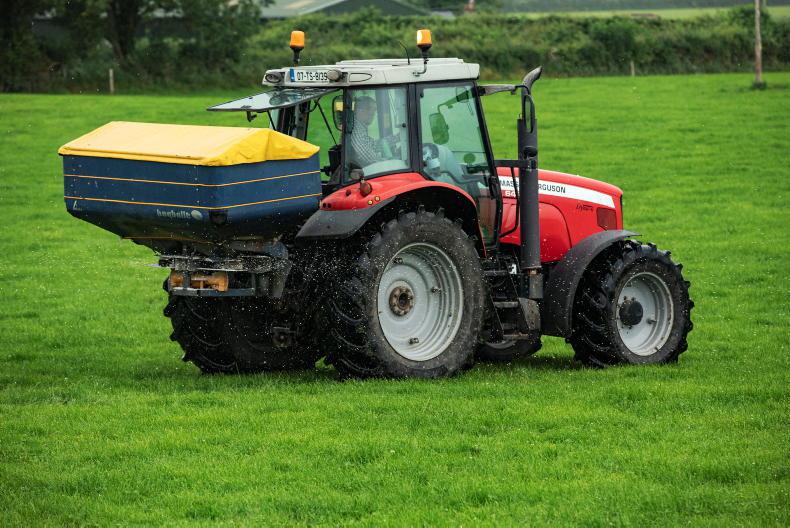



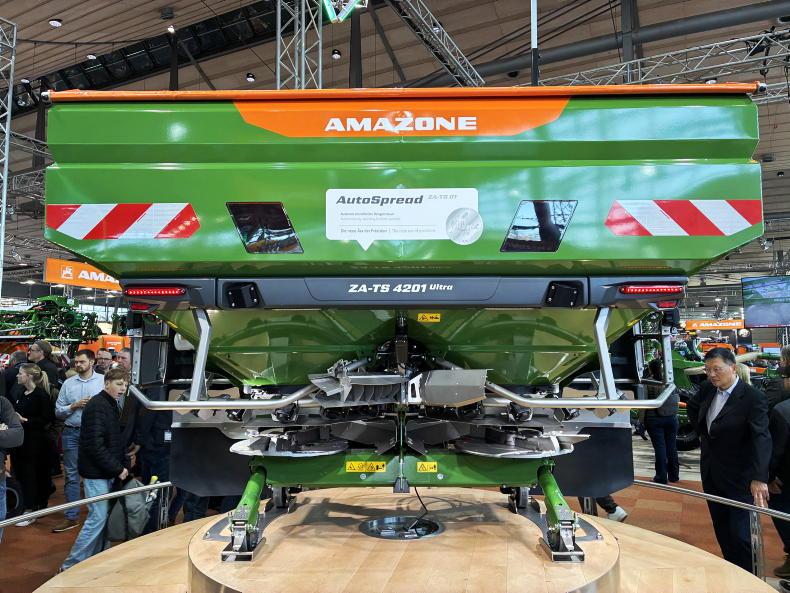
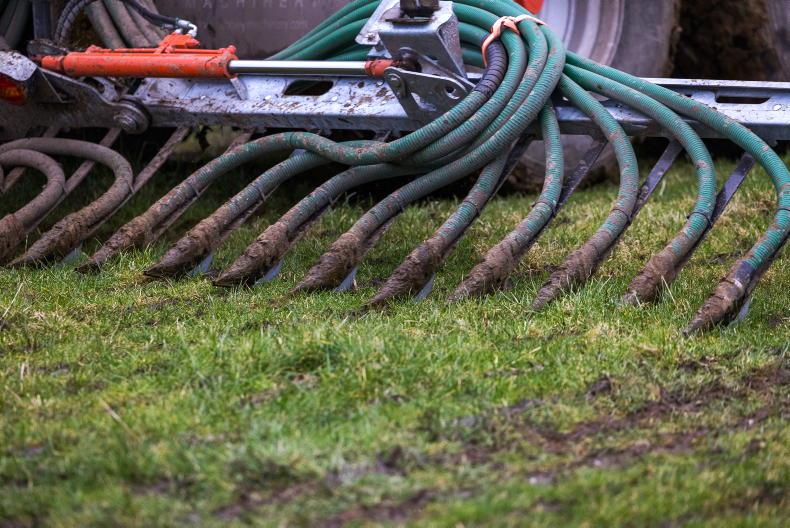
SHARING OPTIONS